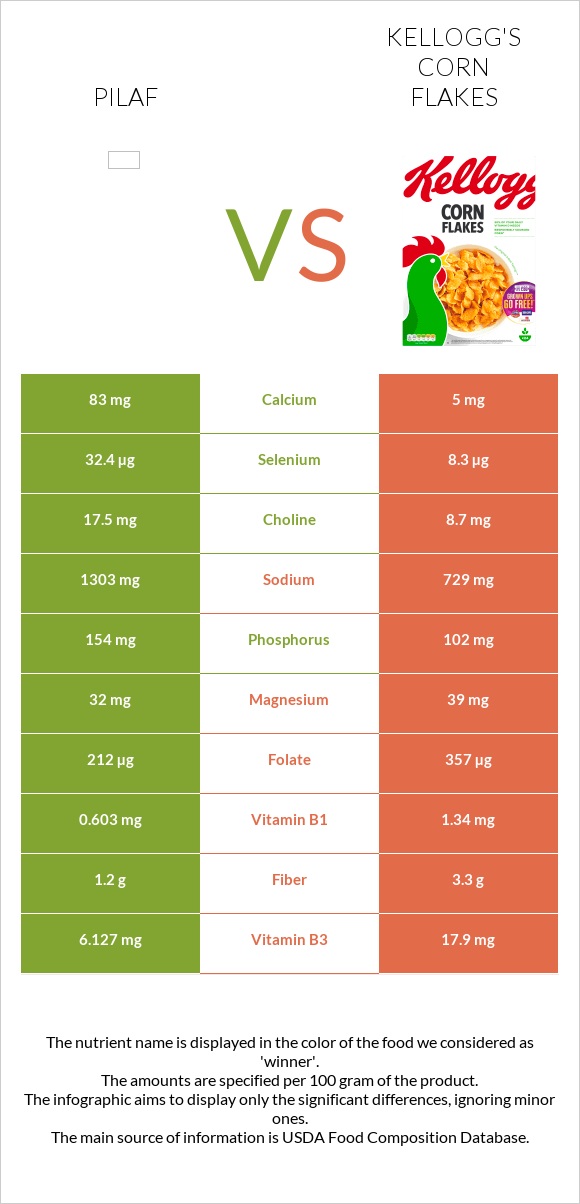Pilaf vs. Kellogg's Corn Flakes — In-Depth Nutrition Comparison
Compare
Important differences between pilaf and kellogg's Corn Flakes
- Pilaf has more selenium and manganese; however, kellogg's Corn Flakes are richer in iron, vitamin B12, vitamin B2, vitamin B6, vitamin B3, vitamin B1, folate, and vitamin A.
- Kellogg's Corn Flakes' daily need coverage for iron is 331% more.
- Pilaf contains 5 times more manganese than kellogg's Corn Flakes. Pilaf contains 0.882mg of manganese, while kellogg's Corn Flakes contain 0.168mg.
- Kellogg's Corn Flakes have a higher glycemic index. The glycemic index of kellogg's Corn Flakes is 80, while the glycemic index of pilaf is 60.
The food varieties used in the comparison are Rice and vermicelli mix, rice pilaf flavor, unprepared and Cereals ready-to-eat, KELLOGG, KELLOGG'S Corn Flakes.
Infographic

Infographic link
Mineral Comparison
Mineral comparison score is based on the number of minerals by which one or the other food is richer. The "coverage" charts below show how much of the daily needs can be covered by 300 grams of the food.
| Contains more CalciumCalcium | +1560% |
| Contains more PotassiumPotassium | +11.9% |
| Contains more PhosphorusPhosphorus | +51% |
| Contains more ManganeseManganese | +425% |
| Contains more SeleniumSelenium | +290.4% |
| Contains more MagnesiumMagnesium | +21.9% |
| Contains more IronIron | +1084.4% |
| Contains more CopperCopper | +19.3% |
| Contains less SodiumSodium | -44.1% |
Vitamin Comparison
Vitamin comparison score is based on the number of vitamins by which one or the other food is richer. The "coverage" charts below show how much of the daily needs can be covered by 300 grams of the food.
| Contains more Vitamin B5Vitamin B5 | +212.2% |
| Contains more Vitamin KVitamin K | +∞% |
| Contains more Vitamin CVitamin C | +412.2% |
| Contains more Vitamin AVitamin A | +12150% |
| Contains more Vitamin EVitamin E | +200% |
| Contains more Vitamin DVitamin D | +∞% |
| Contains more Vitamin B1Vitamin B1 | +122.2% |
| Contains more Vitamin B2Vitamin B2 | +1647.1% |
| Contains more Vitamin B3Vitamin B3 | +192.1% |
| Contains more Vitamin B6Vitamin B6 | +347.5% |
| Contains more Vitamin B12Vitamin B12 | +24900% |
| Contains more FolateFolate | +68.4% |
All nutrients comparison - raw data values
| Nutrient |  |
 |
DV% diff. |
| Iron | 2.44mg | 28.9mg | 331% |
| Vitamin B12 | 0.02µg | 5µg | 208% |
| Vitamin B2 | 0.087mg | 1.52mg | 110% |
| Vitamin B6 | 0.4mg | 1.79mg | 107% |
| Vitamin B3 | 6.127mg | 17.9mg | 74% |
| Vitamin B1 | 0.603mg | 1.34mg | 61% |
| Vitamin A | 4µg | 490µg | 54% |
| Selenium | 32.4µg | 8.3µg | 44% |
| Folate | 212µg | 357µg | 36% |
| Manganese | 0.882mg | 0.168mg | 31% |
| Starch | 71.23g | 29% | |
| Sodium | 1303mg | 729mg | 25% |
| Vitamin C | 4.1mg | 21mg | 19% |
| Vitamin D | 0 IU | 143 IU | 18% |
| Vitamin D | 0µg | 3.6µg | 18% |
| Vitamin B5 | 0.715mg | 0.229mg | 10% |
| Calcium | 83mg | 5mg | 8% |
| Fiber | 1.2g | 3.3g | 8% |
| Phosphorus | 154mg | 102mg | 7% |
| Protein | 10.42g | 7.5g | 6% |
| Copper | 0.166mg | 0.198mg | 4% |
| Carbs | 76.31g | 84.1g | 3% |
| Magnesium | 32mg | 39mg | 2% |
| Choline | 17.5mg | 8.7mg | 2% |
| Fats | 1.37g | 0.4g | 1% |
| Potassium | 188mg | 168mg | 1% |
| Vitamin E | 0.04mg | 0.12mg | 1% |
| Saturated fat | 0.307g | 0.116g | 1% |
| Monounsaturated fat | 0.373g | 0.067g | 1% |
| Polyunsaturated fat | 0.377g | 0.196g | 1% |
| Calories | 359kcal | 357kcal | 0% |
| Protein per 100 calories | 2.902506963788301g | 2.100840336134454g | N/A |
| Calories per 10 g protein | 344.5297504798464kcal | 476kcal | N/A |
| Net carbs | 75.11g | 80.8g | N/A |
| Cholesterol | 1mg | 0mg | 0% |
| Sugar | 1.53g | 9.5g | N/A |
| Zinc | 1.01mg | 1mg | 0% |
| Vitamin K | 0.5µg | 0µg | 0% |
| Tryptophan | 0.086mg | 0.045mg | 0% |
| Threonine | 0.221mg | 0.227mg | 0% |
| Isoleucine | 0.279mg | 0.25mg | 0% |
| Leucine | 0.523mg | 1.044mg | 0% |
| Lysine | 0.189mg | 0.079mg | 0% |
| Methionine | 0.145mg | 0.136mg | 0% |
| Phenylalanine | 0.32mg | 0.374mg | 0% |
| Valine | 0.374mg | 0.306mg | 0% |
| Histidine | 0.15mg | 0.17mg | 0% |
Macronutrient Comparison
Macronutrient breakdown side-by-side comparison
Protein:
10.42 g
Fats:
1.37 g
Carbs:
76.31 g
Water:
8.04 g
Other:
3.86 g
Protein:
7.5 g
Fats:
0.4 g
Carbs:
84.1 g
Water:
3.76 g
Other:
4.24 g
| Contains more ProteinProtein | +38.9% |
| Contains more FatsFats | +242.5% |
| Contains more WaterWater | +113.8% |
| Contains more CarbsCarbs | +10.2% |
~equal in
Other
~4.24g
Fat Type Comparison
Fat type breakdown side-by-side comparison
Saturated fat:
Sat. Fat
0.307 g
Monounsaturated fat:
Mono. Fat
0.373 g
Polyunsaturated fat:
Poly. Fat
0.377 g
Saturated fat:
Sat. Fat
0.116 g
Monounsaturated fat:
Mono. Fat
0.067 g
Polyunsaturated fat:
Poly. Fat
0.196 g
| Contains more Mono. FatMonounsaturated fat | +456.7% |
| Contains more Poly. FatPolyunsaturated fat | +92.3% |
| Contains less Sat. FatSaturated fat | -62.2% |





